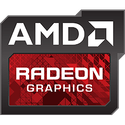Thursday, September 19th 2013

AMD "Hawaii" R9 290X GPU Specifications Revealed
Here are the first set of specifications for AMD's next high-end GPU silicon, on which the company will no doubt carve out several SKUs from. Codenamed "Hawaii," and slated for unveiling on the 26th in, well, Hawaii, the 28 nm chip is what AMD will take NVIDIA's GK110 silicon head-on with. It is based on AMD's second-generation Graphics CoreNext micro-architecture.
With an estimated die-area of 430 mm² (18% bigger than "Tahiti,") the chip physically features 2,816 stream processors (SPs) spread across 44 clusters with 64 SPs each (a 37.5% increase over "Tahiti"). The chip features four independent raster engines, compared to two independent ones on "Tahiti." This could translate into double the geometry processing muscle as "Tahiti," with four independent tessellation units. The memory interface of the chip is expected to be 384-bit wide, based on the GDDR5 specification. Given the way TMUs are arranged on chips based on this architecture, one can deduce 176 TMUs on the chip. The ROP count could be 32 or 48. The chip will feature hardware support for DirectX 11.2, including the much hyped shared resources (mega-texture) feature.
Source:
3DCenter.org
With an estimated die-area of 430 mm² (18% bigger than "Tahiti,") the chip physically features 2,816 stream processors (SPs) spread across 44 clusters with 64 SPs each (a 37.5% increase over "Tahiti"). The chip features four independent raster engines, compared to two independent ones on "Tahiti." This could translate into double the geometry processing muscle as "Tahiti," with four independent tessellation units. The memory interface of the chip is expected to be 384-bit wide, based on the GDDR5 specification. Given the way TMUs are arranged on chips based on this architecture, one can deduce 176 TMUs on the chip. The ROP count could be 32 or 48. The chip will feature hardware support for DirectX 11.2, including the much hyped shared resources (mega-texture) feature.
97 Comments on AMD "Hawaii" R9 290X GPU Specifications Revealed
Just for comparison:
Tahiti has 2048 SP in 365mm^2 -> 5.61 SP/mm^2
Hawaii has 2816 SP in 430mm^2 -> 6.55 SP/mm^2
That means Hawaii is about 17% more die area efficient than Tahiti. Granted, most of the auxiliary logic like the memory controller and PCI express controller don't increase in size with the number of SP, but it's still a nice improvement.
AMD wanted to be the first with full hardware support for Windows 8.1. Not that it had to worry since its competitor is still doing only doing half compliance with software on DX 11.1.
The Forbes interview indicated that they could achieve higher clock speeds at 28nm than 20nm, so that makes me wonder if either this 900mhz clock is too low or if the 20nm process is that bad. I tend to believe the latter.
Even if AMD managed a transistor density ~Pitcairn, that seems a little out of balance.Kind of puts Pitcairn's 6.04 SP/mm^2 to shame if that is indeed the case.Might be a case of transistor density translating into higher localised heat (i.e. the Ivy Bridge and Haswell effect)
2816x + y = 430
2048x + y = 365
where x is the die area per SP and y is the die area occupied by everything other than the SPs.
This works out to be y (uncore die area) = 192 mm^2 and x (die area per SP) = 0.0846 mm^2. This would mean that if Tahiti's SP's were identical to the ones in Hawaii then Tahiti would be 52% uncore. But just looking at die pictures of Tahiti shows that this is obviously untrue.
So some serious optimizations have to had been done. Credit is due to AMD for making such a die area efficiency gain without reducing the process size. Where performance lines up is yet to be told though.
EDIT: this increase in efficiency not be true, see my post belowThe R9 290X is clocked 16% lower than the 7970 GHz Edition but has 37.5% more SP. If the performance of Hawaii scales linearly with SP and clock speed with respect to Tahiti, then based on the TPU performance chart the R9 290X should be 97% as fast as GTX 780. If a dynamic boost mode is implemented (ala 7790) as has been rumored then they should be neck and neck in performance, possibly with the R9 290X being a little faster if it can boost over 1GHz consistently. However, as with any product the price is what will really determine a winner. But even if the R9 290X is priced the same as GTX 780, the R9 290X should be the better buy.
1. AMD and Nvidia don't reach some kind of unwritten (and non verifiable) understanding, and
2. Yields and production ramp is sufficient to make 1. unnecessary.
BTW: I Googled the Tahiti die shot image you posted, and a poster at B3D (fellix) cleaned up the image(or one very similar) which should make calculations easier....assuming of course that there isn't a radical difference in architecture which I think would be unlikely
What precisely would AMD cull to decrease size? Cache ? Vector and texture units ? the number of load/store units ?
The other alternatives are AMD have made some breakthrough in transistor density...or Tahiti was a badly laid out chip.
Burn burn burn baby.... XD
cant wait for benches and reviews.